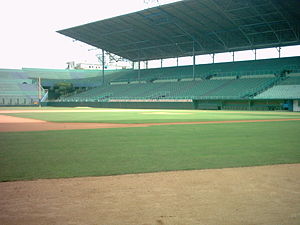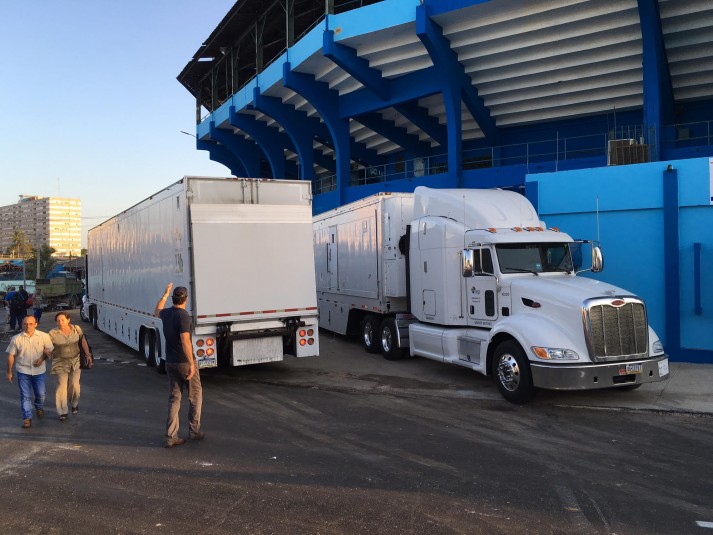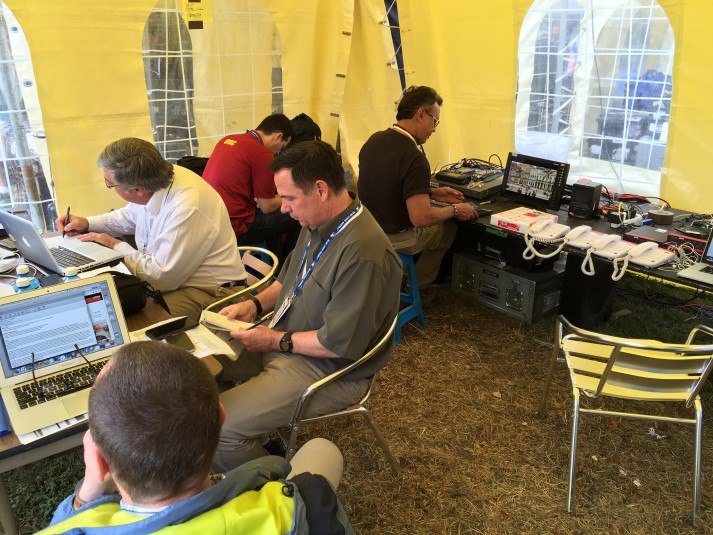Despite Logistical Challenges, ESPN Gives Historic MLB Game in Cuba the A-Game Treatment
A lack of HD facilities, changing travel rules, not to mention politics complicate the production effort
Story Highlights
As U.S.-Cuba relations continue to thaw, the two nations’ shared pastime is serving as the backdrop for history in the making. The first sitting U.S. president to visit Cuba since 1928, President Barack Obama will be in the stands at Estadio Latinoamericano in Havana today to watch the Tampa Bay Rays take on the Cuban national team.
Although it may be just an exhibition game on paper, ESPN will roll out a full production complement — on par with its Wednesday Night Baseball regular-season MLB package — to cover the monumental moment.

Havana’s Estadio Latinoamericano, where the Tampa Bay Rays play the Cuban national team today
“In terms of how we frame the significance of this [telecast], we want to focus on how, despite 56 years of embargo, baseball is something that the two countries have always shared a passion for,” says ESPN Coordinating Producer Phil Orlins. “I don’t know that any event we have ever done had quite this kind of political angle tied to it. A baseball game is serving as the centerpiece of an incredible world event; you just don’t get many like that.”
Of course, given Cuba’s lack of HD production facilities, evolving travel regulations between the two countries, and the fact that this will be the first MLB game played in Cuba since 1999 (Baltimore Orioles vs. Cuban National Team exhibition March 28, 1999), ESPN faced no shortage of logistical challenges along the way.
“The unique thing is, even if we went to other countries, we had a pretty good grasp of what’s available and what to expect,” Terry Brady noted this week. “We really don’t know what to expect when we get down there, so there’s going to be a lot of shooting from the hip on this one. But we feel really confident we have the right people, the right equipment, and the right partners to pull this off. There’s a little bit of fear of the unknown, but it’s also exciting. We will adapt as we go, and we’ll put great television on on the 22nd.”
A Moving Target: The Run-Up to MLB’s Return to Cuba
ESPN’s production and operations teams were initially informed about the game in January and traveled to Havana for a site survey in mid February. The original plan was for the Cuban national broadcaster to produce a world feed out of an RTV Commercial mobile unit (perhaps the only HD truck in Cuba) while ESPN provided a handful of unilateral cameras and its own announcers and graphics.
However, when Obama’s visit became official, the Cuban national broadcaster opted to reassign its facilities for news coverage. This forced ESPN to act quickly, securing U.S.-based remote-production facilities and floating them over via barge in time for the game. Then, in the second week of March, the Cubans reversed course and opted to, in fact, produce its own show. However, since ESPN had already shipped over the facilities, the game now has two full productions onsite, with a handful of shared cameras.
“Once we put that plan in motion to really beef up our coverage,” said Brady, “there really wasn’t any turning back, because you had to get all the clearances to get the trucks over, all the permits, and provide for the shipping. When Cuban television came back into the mix, we stuck to our plan. Now we’re just dealing with how to manage signal flow in 720p or 1080p, how we’re going to actually convert [those signals], and figure out signal distribution and workflows. But we’re fully prepared to do that.”
In addition to NEP’s SS23, which is serving as the mobile unit, ESPN shipped an Illumination Dynamics twin-pack generator, as well as a box truck with a flypack inside and a variety of complementary gear from Bexel and CP Communications on March 5 from the Port of Miami.
The bulk of the operations crew and technical crew arrived in Havana on Friday and parked the truck on Saturday. Setup at the ballpark took place on the Sunday, and ESPN went live from the ballpark on Monday morning beginning with the Rays’ pregame workout.
“Since this is all new for us,” says Brady, “we are giving ourselves some extra time for setup.”
The Challenges of a 70-Year-Old Ballpark
ESPN will deploy seven hard cameras and two handhelds for its game coverage; the Cuban telecast, eight or nine. ESPN plans to share the high-home angle and possibly more.
“Although [Estadio Latinoamericano] has traditional positions, they’re a little bit different from what we would experience as a regular ballpark in the U.S.,” says Orlins. “For instance, low cameras are not in traditional dugout positions: the centerfield position is a little off-center, and the high-home position is a little bit different. So, while the coverage is going to be close to what we do in the United States, it is not going to be exactly [the same] as it relates to camera angles. The Cubans will probably take some of the primary positions, and we’ll have to adapt and either find alternative positions or go on a modified side-by-side situation.”
Major League Baseball and the Estadio Latinoamericano facilities team in Havana also had some work to do to bring the aging ballpark (built in 1946) to bring it up to MLB standards.
“The venue was not in a great physical condition when we got there, and MLB certainly had some challenges to get the field up to condition, but the team down there has done an unbelievable effort to get the ballpark up and running,” says Orlins. “Considering where it was just a month ago, it’s pretty impressive. I think it will be venue the Cuban people are proud to present on a world stage.”
ESPN Deportes will produce its own Spanish-language telecast using ESPN’s camera feeds plus one unilateral camera.
Beyond the Action on the Field
Although ESPN has rolled out a sizable production complement to cover the game itself, the network has no shortage of ancillary content planned, highlighted by an in-booth visit with Obama that is likely to last a full-inning.
“I think it’ll be a little bit of a different spin,” says Orlins. “The game will definitely be heavy on ancillary content, highlighted by a visit with President Obama. I can’t overstate how central that whole aspect is for us. This is the first visit by a sitting U.S. president to Cuba in 88 years, and we’re going to spotlight that. But there are other angles that we’re really interested in as well, such as Cuban baseball players’ potentially coming to Major League Baseball without defecting relatively soon.”
ESPN Monday Night Baseball analyst Eduardo Perez, the son of Cuban Baseball Hall of Famer Tony Perez, will provide analysis for the game. He’ll be joined by ESPN Wednesday Night Baseball analyst Doug Glanville and play-by-play commentator Karl Ravech (Baseball Tonight, Monday Night Baseball). Additionally, ESPN reporter Pedro Gomez, the son of Cuban refugees, will provide reports, alongside ESPN MLB Insider Tim Kurkjian.
More Than Just the Game in Havana
In addition to the production at Estadio Latinoamericano, ESPN and ABC News also erected a standup location near El Capitolio in Havana. In addition to ABC News’ coverage, Outside the Lines and SportsCenter hosted shows from this location on Sunday and Monday. A 90-minute edition of SportsCenter live at Estadio Latinoamericano will air prior to the game (12:00-1:30 p.m. ET) today.
ESPN also plans to follow Rays pitcher Chris Archer, who served as a guest analyst for ESPN’s Wild Card Postseason coverage last year, around Havana on Monday, creating content that takes a deeper look at Havana’s culture and Archer’s interactions with the local community.
“It will be a pretty vast ESPN production in the sense of both game coverage and news coverage leading up to it,” says Orlins. “I’ll be honest, I don’t remember an event quite like this.”



